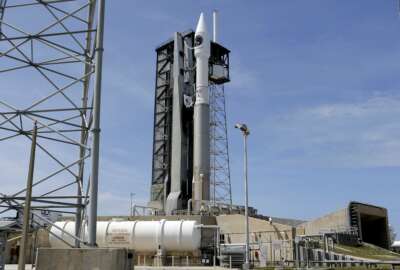Best listening experience is on Chrome, Firefox or Safari. Subscribe to Federal Drive’s daily audio interviews on Apple Podcasts or PodcastOne.
After all the late night jokes and Star Wars references, the Defense Department is actually getting down to business on creating a U.S. Space Command and building the blueprints for a space force.
There is still a long road ahead, but right now the Pentagon’s first order of business is following the 2019 defense authorization act. The law requires DoD to create a sub-unified Space Command.
Chairman of the Joint Chiefs of Staff Joseph Dunford said that process is already underway when he and Defense Secretary Jim Mattis held a press conference at the Pentagon Tuesday.
“In fact, as recently as yesterday I met with the key leaders in the department to work through the details. We are still a few months away from standing up that command and coming to the secretary with a recommendation with specific details,” Dunford said.
Mattis said he expects the costs of setting up the command will be fairly small.
“Setting up the combatant command will not be that expensive, because we will build out on what we have right now,” Mattis said. “We have not done the costing estimates, that’s underway right now [for Space Command and space force], but I don’t want to give an off the cuff number that’s not examined.”
What Mattis means by building out what DoD has now is that the military will use the resources it has in other military services relating to space.
The Air Force has its own Space Command which will most likely be folded into the new command. Each of the other services also have space assets they will contribute.
The sub-unified command is supposed to be finished by the end of the year. Sub-unified commands are subordinate to full combatant commands. A good example would be U.S. Alaska Command, which is responsible for operations in and around Alaska. That command falls under U.S. Northern Command, which is a full combatant command in charge of protecting pretty much all of North America.
Space Command will fall under U.S. Strategic Command until it gets its legs under it and becomes a full unified command, but in the meantime it has plenty of work cut out for it. The 2019 defense authorization act gives Space Command the authority to develop strategy and tactics, training and certification of forces and the responsibility for establishing priorities for requirements.
One of the most daunting tasks ahead of Space Command is the legal requirement to come up with a place for a “separate, alternative acquisition system” for space.
The new acquisition process may use the Joint Capabilities Integration and Development System — a process that uses joint concepts, doctrine and organization to resolve issues. Another option is to completely start from scratch and create a new requirements process that ensures “requirements for a program are synchronized across the space vehicles, ground segments,” the law states.
As for the space force, that issue is a much longer game and its actual fruition is ambiguous. While Space Command will set up some of the bureaucracy needed to build the force, the space service is not codified in law and Mattis was not going to even hint at what it would cost to set the service up.
“While revising our vision for defending our assets in space and revising antiquated space acquisition processes, we are working with Congress on our way ahead for a separate department,” Mattis said.
DoD will run into some serious roadblocks on its way to creating a space force. It needs to get Congress on board to create the force and it needs to consider the budgetary implications.
Adam Routh, a research associate at the Center for a New American Security, said adding a space force is like adding another lion to fight over the budget meat.
“We are taking money from the other services,” Routh said. “There would be some money that would come from what we already spend on space. What the Air Force gets, for example, or what the other branches are spending on space, but it wouldn’t be enough. It would need to come from other parts of the defense budget and it’s going to be substantial. You can’t set up a space force or any kind of force from the pennies left over from the programs we decide are unnecessary,” Routh said.
That’s an issue because Congress likely won’t be adding more funds to DoD’s budget in the coming years and Congress will have to deal with the return of the Budget Control Act.
That means lawmakers will have to come to an agreement on how much money they are willing to spend in 2020. That could make lawmakers less likely to spend big money on a space force, or if sequestration returns, could make a deep cut in DoD’s budget.
In any case, Mattis made it clear DoD will be treating space seriously in the future.
“We recognize cyberspace and outer space are warfighting domains on par with air, land and sea and these two domains were made contested domains by the actions of others. As a result … we are working with Congress and the White House to define the evolving space problem that we confront,” he said.
Copyright
© 2024 Federal News Network. All rights reserved. This website is not intended for users located within the European Economic Area.


